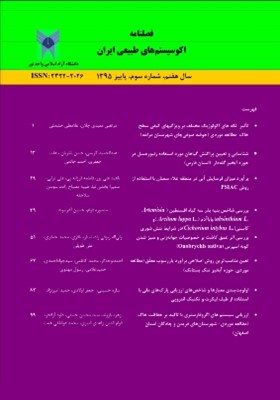اولویت بندی معیارها و شاخصهای ارزیابی پارکهای ملی با استفاده از طیف لیکرت و تکنیک انتروپی
محورهای موضوعی : جنگلداریساره حسینی 1 , جعفر اولادی 2 , حمید امیرنژاد 3
1 - دانشجوی دکتری جنگلداری دانشگاه کشاورزی و منابع طبیعی ساری، دانشکده منابع طبیعی ساری، ایران.
2 - دانشیار گروه جنگلداری، دانشگاه علوم کشاورزی و منابع طبیعی ساری، دانشکده منابع طبیعی ساری، ایران.
3 - دانشیار گروه اقتصاد کشاورزی، دانشگاه کشاورزی و منابع طبیعی ساری، دانشکده منابع طبیعی ساری، ایران.
کلید واژه: روش دلفی, طیف لیکرت, تکنیک انتروپی, پارکهای ملی,
چکیده مقاله :
در این پژوهش به منظور اولویت بندی معیارها و شاخص های اکولوژیکی، اقتصادی و اجتماعی ارزیابی پارک های ملی از دو دیدگاه علمی (اعضای هیأت علمی دانشگاه ها) و عملی (متخصصان محیط زیستی در سازمان ها)، از تکنیک انتروپی و طیف لیکرت با طراحی پرسشنامه دلفی استفاده گردید. تجزیه و تحلیل یافته های حاصل از پاسخ دهندگان به پرسشنامه دلفی بر اساس طیف لیکرت نشان داد که از دیدگاه علمی، شاخص های ارزش زیباشناختی با وزن (62/4)، ارزش تفرج با وزن (5/4) و سطح جنگل های بکر با وزن (29/4) و از دیدگاه عملی، شاخص های ارزش زیباشناختی با وزن (38/4) و سطح جنگل های بکر و ارزش تفرج هر دو با وزن (16/4) به ترتیب به عنوان مهمترین و مؤثرترین شاخص ها در ارزیابی پارک های ملی می باشند. بر اساس تکنیک انتروپی از هر دو دیدگاه علمی و عملی سه شاخص مؤثر برای ارزیابی پارک های ملی به ترتیب وزن شامل سطح و درصد جنگل ها و دیگر اراضی چوب ده از قبیل جنگلکاری ها، آگروفارستری و کمربندهای سبز به همراه تغییراتشان، وسعت توده های آمیخته، زون بندی و تعیین زون ضربه گیر می باشد. اولویت بندی معیار ها نیز با استفاده طیف لیکرت از دیدگاه های علمی و عملی نشان داد که معیارهای حفاظت از تنوع زیستی، گستره منابع جنگلی و عملکردهای زیست محیطی و حمایتی با رتبه مبتنی بر میانگین وزنی بیشتر، اهمیت و نقش این معیارها را در مقوله ارزیابی پارک های ملی بیش از بیش روشن تر می سازد. همچنین نتایج حاصل از اولویت بندی معیار ها بر اساس تکنیک انتروپی در این مطالعه از دیدگاه های مختلف نشان داد که معیارهای عملکردهای زیست محیطی و حمایتی، حفاظت از تنوع زیستی، حفظ، توسعه عملکرد شرایط اجتماعی به ترتیب حائز رتبه های برتر شدند.
In this study for the priority of ecological, economic and social indicators of national parks in terms of scientific and practical was used of Entropy and Likert techniques whit planning questionnaire. The Analysis of result of study using Likert technique showed that of two aspects scientific (Teachers in university) and practical (environment experts in organs) , esthetic value indicator whit 4/62 weight, value of recreation whit 4/5 weight and area of virgin forests whit 4/29 weight and aspects practical, aesthetic value indicator whit 4/38 weight, value of recreation and area of virgin forests whit 4/16 are the most important and effective indicators in the national parks respectively. Three basic indicators for assessment of national parks based onweight of entropytechnique of two aspects scientific and practical contain area and percentage of forests and “other wooded lands” (including plantations, agroforestry, shelterbelts) with their change over time (deforestation, reforestation and conversion), extent of mixed stands and zonation and determination of buffering zone respectively. The priority of criteria using ofLikert technique showed that the conservation of biodiversity, extent of forest resources and protective and environmental functions whit more weight have important role in assessment national parks. Also in this study the result of the priority of criteria based on entropy and technique of different aspects showed that protective and environmental functions, conservation of biodiversity, maintenance and development of social functions and conditions became better priority respectively.
16.Munroe, K., 2008. Monitoring landscape fragmentation in an inaccessible mountain area: Celaque national park, western Honduras, Journal of environmental management, 12 pp.
19.Sherrouse, B.C. Semmens, D.J and Clement, J.M., 2014. An application of social values for ecosystem services (SOlVES) to three national forests in Colorado and Wyoming. Ecological Indicators 36: 68–79.
20.Timko, A., 2010. Evaluating ecological integrity in national parks; case studies from Canada. Journal of Environmental Management, 16p.
21.Weaver, D., Oppermann, M., 2000. Tourism management, Australia, Wiley, 468pp.
23.Young J.C., Jordan, A., Searle, K.R., Butler, A., Chapman, D.S., Simmons, P and Watt, A.D., 2013. Does stakeholder involvement really benefit biodiversity conservation? Biological conservation 158: 359–370.
_||_
16.Munroe, K., 2008. Monitoring landscape fragmentation in an inaccessible mountain area: Celaque national park, western Honduras, Journal of environmental management, 12 pp.
19.Sherrouse, B.C. Semmens, D.J and Clement, J.M., 2014. An application of social values for ecosystem services (SOlVES) to three national forests in Colorado and Wyoming. Ecological Indicators 36: 68–79.
20.Timko, A., 2010. Evaluating ecological integrity in national parks; case studies from Canada. Journal of Environmental Management, 16p.
21.Weaver, D., Oppermann, M., 2000. Tourism management, Australia, Wiley, 468pp.
22-Yonesian, M., Shariatti, M and Zamani, Gh., 2009. Looks and challenges shaping the health challenges and guilt in Tehran University of Medical Sciences using the Delphi method. Journal of Medical Research, 3 (1): 9-20. .(In Persian)
23.Young J.C., Jordan, A., Searle, K.R., Butler, A., Chapman, D.S., Simmons, P and Watt, A.D., 2013. Does stakeholder involvement really benefit biodiversity conservation? Biological conservation 158: 359–370.


